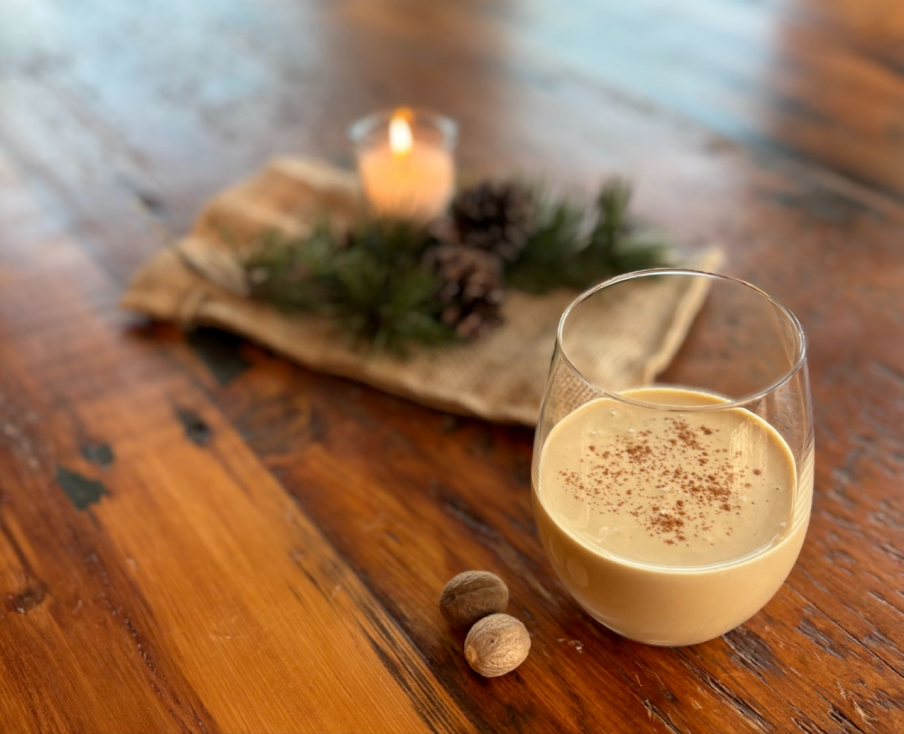December is definitely my favorite time of year. I love the holiday season. A huge part of that isn’t just Christmas itself, but everything that happens leading up to Christmas. It’s all the little things…frosty mornings, the first snowfall (I grew up in Minnesota, so snow came early!), the perfect Christmas tree, drinking hot chocolate by the fireplace, lights twinkling in the windows… and of course, eggnog.
If there’s one drink I love most in the world (except coffee, which deserves its own category!), it’s eggnog.
Rich, creamy, smooth...with hints of nutmeg, cinnamon, and vanilla… it automatically makes me think of Christmas. Quite often in December, you can find me curled up on the couch in front of the fireplace, reading a book and enjoying a glass of eggnog.
This week, I wanted to share with you my favorite recipe for homemade eggnog. It takes some time to make, but the results are SO worth it!
Store-bought eggnog can’t compare to homemade.
Whether you want to treat yourself to help get you in the Christmas spirit, or whether you want to have a special treat for your loved ones on Christmas Day, I guarantee you’ll love this recipe!
This recipe is a cooked version. While raw eggnog is still mouthwatering, I personally like it cooked better. I think it gets a richer, creamier consistency that is absolutely amazing!
One tip for making this recipe is - patience! You can’t rush perfection! Cook your eggnog at a low temp to avoid cooking the eggs too fast. That way it doesn’t get clumps of scrambled eggs or start to taste too “egg-y.” And I promise, the patience pays off!
Ready to make your own? Grab the ingredients and follow the recipe below, and bring your eggnog game to a whole new level!
Perfect Homemade Egg Nog Recipe
What you’ll need:
6 large Whiffletree egg yolks⅓ cup sucanat, coconut sugar, or maple sugar1 cup heavy cream2 cups whole milk1 cinnamon stick1 vanilla bean, or ¼ tsp vanilla extractPinch of salt¼ tsp ground nutmeg (fresh ground nutmeg is the way to go! I just use a lemon zester to grate what I need from a whole nutmeg…otherwise already ground nutmeg works just fine!)Optional: ¼ cup bourbon, whisky or rum
Here's how to make it:
First, whisk the egg yolks with the sweetener of your choice until it turns a light color and is creamy.
Next, add the milk to a medium saucepan and warm over medium-low heat. Once you begin to see steam rising from the milk, measure out one cup of the heated milk. Slowly pour the milk into your egg mixture, whisking the entire time to make sure the milk doesn’t cook your eggs. This helps to temper your eggs, or warm them up so the shock of adding them to the hot milk doesn’t fry them. Next, take the tempered eggs and slowly pour them into your saucepan with the heated milk, again stirring the entire time. Add in the cinnamon stick and vanilla bean, if using.
Keep the heat on medium-low. (Don’t get impatient and turn the heat up too high - you’ll cook your eggs too fast and end up with a clumpy mess!) Using a wooden spatula, slowly stir the mixture as it cooks, making sure to scrape the bottom of the pan to keep bits of eggs from sticking to the bottom.
After about ten minutes, you should see the mixture begin to thicken. Test the temperature with a thermometer - you want it to get to 160 F before taking it off the heat. (The mixture will further thicken as it cools in the fridge.) Another way to test the thickness is by dipping your wooden spatula into the mixture and taking it back out - if the egg mixture coats the spatula and doesn’t just run off, it’s ready. But if you’re not experienced making eggnog, use your thermometer to make sure!
Once it reaches 160 F, pour the egg mixture through a strainer into a bowl or jar. This will make sure you don’t end up with unpalatable clumps of eggs in your drink.
If you used the vanilla bean, cut it in half down the length of it, and use a butter knife to scrape all the vanilla bean seeds from inside the pod. Add that into your egg mixture and whisk to incorporate. If you didn’t use the vanilla bean, add in your vanilla extract. Next, add in the nutmeg. Then cover the mixture and set into the fridge to cool it down.
While the egg mixture is cooling, pour ½ cup of the heavy cream into a bowl. Using a hand mixer, beat the cream until it thickens and forms soft peaks.
Once the egg mixture is cold, add in the whipped cream with the other ½ cup of heavy cream and whisk it together to incorporate. Don’t whisk too fast as you don’t want to break the cream down too much…whisk slowly and just enough to mix the two together.
If you want to make it alcoholic, add in a quarter cup rum, whisky or bourbon.
And there you have it! The best, most delicious eggnog. It’s so creamy and smooth…you’ll never want to go back to store-bought again!
Stop on by the farm store, pick up your eggs, and give this recipe a try! Make sure to let us know what you think!
Have you ever had homemade eggnog before? Comment below and tell us how you like to make it!
Cheers!
~Bethany




